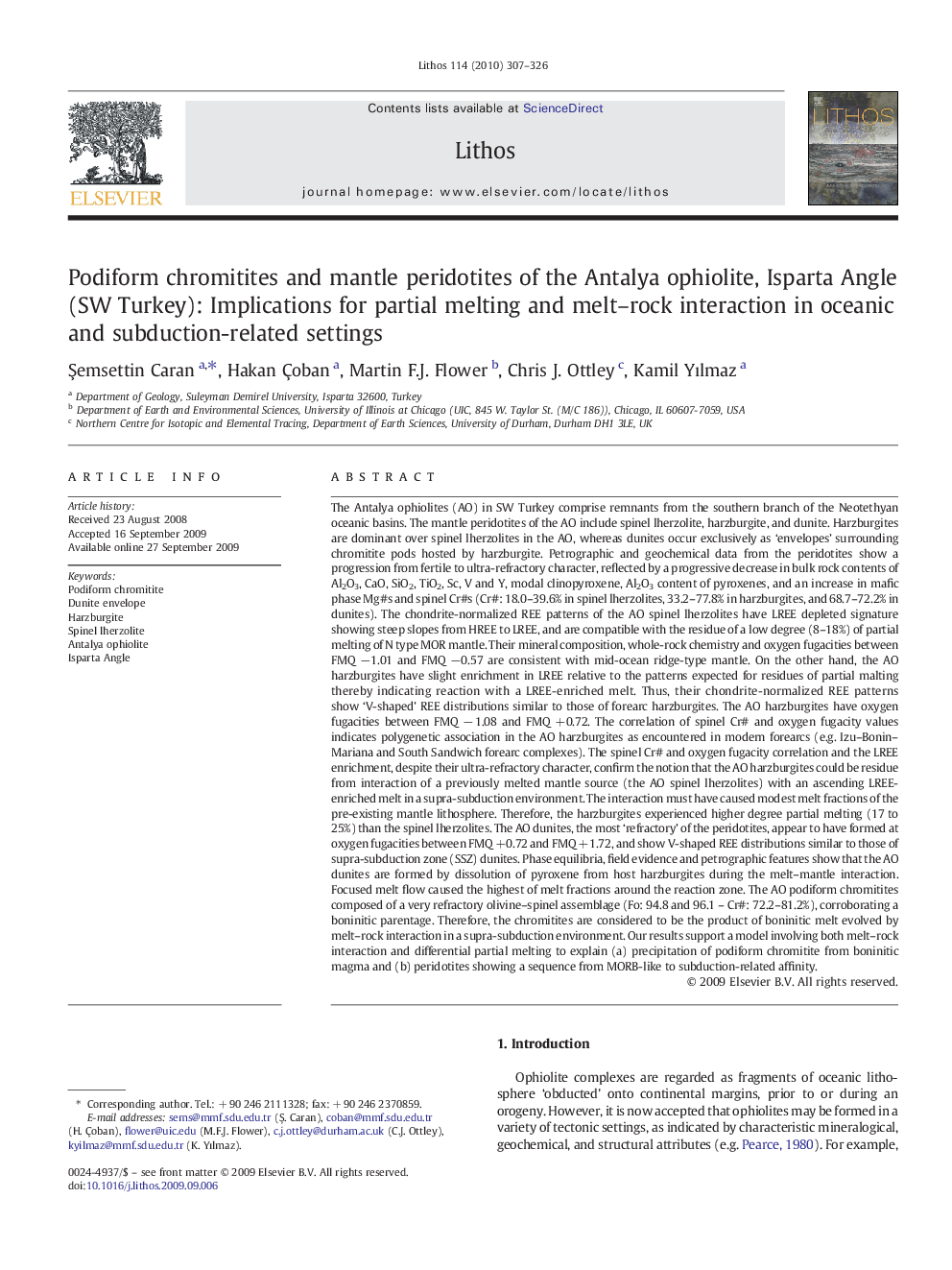| کد مقاله | کد نشریه | سال انتشار | مقاله انگلیسی | نسخه تمام متن |
|---|---|---|---|---|
| 4717157 | 1638736 | 2010 | 20 صفحه PDF | دانلود رایگان |

The Antalya ophiolites (AO) in SW Turkey comprise remnants from the southern branch of the Neotethyan oceanic basins. The mantle peridotites of the AO include spinel lherzolite, harzburgite, and dunite. Harzburgites are dominant over spinel lherzolites in the AO, whereas dunites occur exclusively as ‘envelopes’ surrounding chromitite pods hosted by harzburgite. Petrographic and geochemical data from the peridotites show a progression from fertile to ultra-refractory character, reflected by a progressive decrease in bulk rock contents of Al2O3, CaO, SiO2, TiO2, Sc, V and Y, modal clinopyroxene, Al2O3 content of pyroxenes, and an increase in mafic phase Mg#s and spinel Cr#s (Cr#: 18.0–39.6% in spinel lherzolites, 33.2–77.8% in harzburgites, and 68.7–72.2% in dunites). The chondrite-normalized REE patterns of the AO spinel lherzolites have LREE depleted signature showing steep slopes from HREE to LREE, and are compatible with the residue of a low degree (8–18%) of partial melting of N type MOR mantle. Their mineral composition, whole-rock chemistry and oxygen fugacities between FMQ −1.01 and FMQ −0.57 are consistent with mid-ocean ridge-type mantle. On the other hand, the AO harzburgites have slight enrichment in LREE relative to the patterns expected for residues of partial malting thereby indicating reaction with a LREE-enriched melt. Thus, their chondrite-normalized REE patterns show ‘V-shaped’ REE distributions similar to those of forearc harzburgites. The AO harzburgites have oxygen fugacities between FMQ − 1.08 and FMQ +0.72. The correlation of spinel Cr# and oxygen fugacity values indicates polygenetic association in the AO harzburgites as encountered in modern forearcs (e.g. Izu–Bonin–Mariana and South Sandwich forearc complexes). The spinel Cr# and oxygen fugacity correlation and the LREE enrichment, despite their ultra-refractory character, confirm the notion that the AO harzburgites could be residue from interaction of a previously melted mantle source (the AO spinel lherzolites) with an ascending LREE-enriched melt in a supra-subduction environment. The interaction must have caused modest melt fractions of the pre-existing mantle lithosphere. Therefore, the harzburgites experienced higher degree partial melting (17 to 25%) than the spinel lherzolites. The AO dunites, the most ‘refractory’ of the peridotites, appear to have formed at oxygen fugacities between FMQ +0.72 and FMQ +1.72, and show V-shaped REE distributions similar to those of supra-subduction zone (SSZ) dunites. Phase equilibria, field evidence and petrographic features show that the AO dunites are formed by dissolution of pyroxene from host harzburgites during the melt–mantle interaction. Focused melt flow caused the highest of melt fractions around the reaction zone. The AO podiform chromitites composed of a very refractory olivine–spinel assemblage (Fo: 94.8 and 96.1 – Cr#: 72.2–81.2%), corroborating a boninitic parentage. Therefore, the chromitites are considered to be the product of boninitic melt evolved by melt–rock interaction in a supra-subduction environment. Our results support a model involving both melt–rock interaction and differential partial melting to explain (a) precipitation of podiform chromitite from boninitic magma and (b) peridotites showing a sequence from MORB-like to subduction-related affinity.
Journal: Lithos - Volume 114, Issues 3–4, February 2010, Pages 307–326